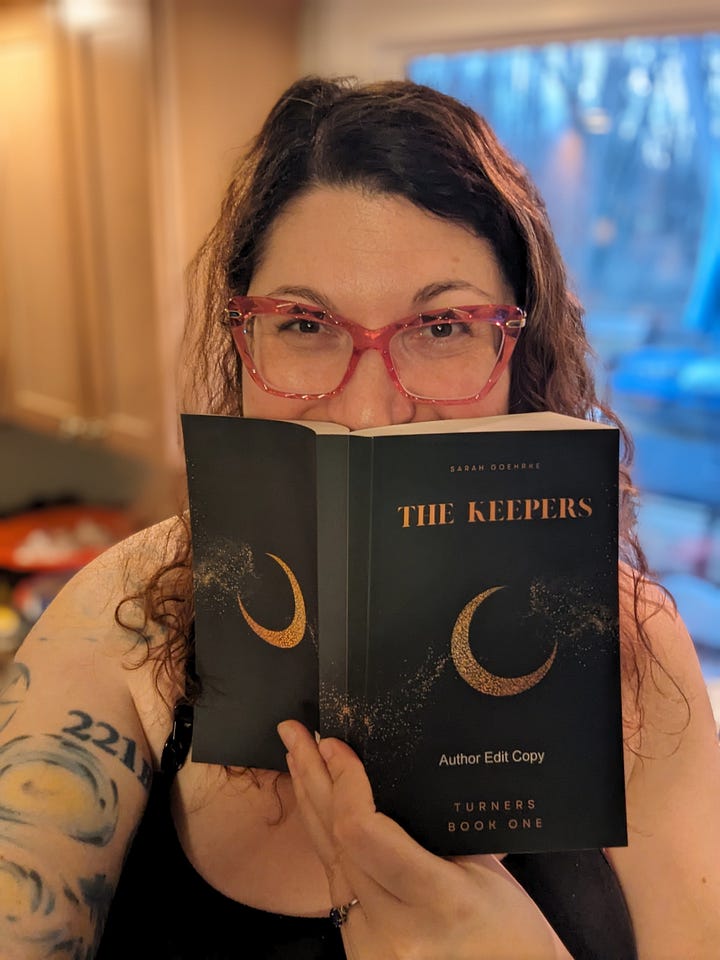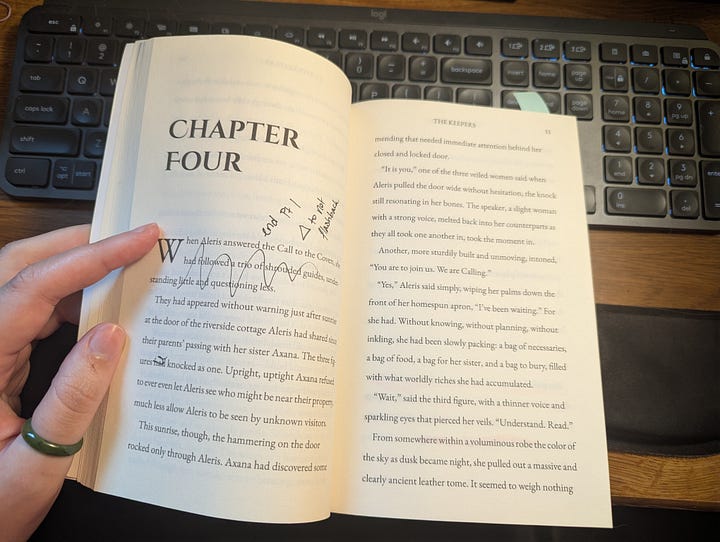This morning, fabulous author Beth Revis posted an incredibly helpful Thread about the math of publishing, specifically focusing on a realistic comparison of royalties for self-publication and traditional publication.
That got me thinking.

I’m a words girl, not a math one; ask my B-on-a-good-day scores through school years when I took advanced math classes that I truly had no business taking. This established, I appreciate other people doing the math that sends my mind into blue screen mode.
There’s so much more to the numbers side of publication than royalty percentages, sales figures, and projected earnings (and the all-important earning-out of advances).
I wrote up a quick Thread on a little more of this math, quoting Beth’s OG Thread. Let’s expand on the ideas I typed up on my phone before taking the child to summer camp, now that I have a full keyboard and a minute to think.
The Numbers Side of Words
Authors write because we love it, because we have stories to tell—and we publish them because we want to share those stories.
I am by no means the only word-not-math writer, when we look big picture. Thing is, when it comes to publishing, the numbers also matter.
I write for the love of it, but as society likes to remind us, love doesn’t pay the bills. And there are so very, very many bills, living in late stage capitalism. So, it’s a lovely thing to be paid for doing what we love—and for readers to support the authors creating the worlds they come to love. That means selling books.
What does that look like, considering books as more than the sum of their words?
% and $ Math
I’d love to refer you again to Beth’s excellent Thread to run down a lot of this, where it comes to sorting out percentages of royalties that make their way to authors. In short, as Beth sorted:
Self-published authors may get 70% of a book sale while a trad-pubbed author takes in 10% of a sale—which at first glance seems like, whoa, I’d rather have $7 from a $10 sale than $1.
But obviously that’s not the whole story, because of all that’s gone into getting that book saleable in the first place.
Editing, formatting, cover design, blurbs, bookstore placement / distribution, marketing, all those things that have to happen first. With trad pub, the publisher does some or most or all of those; for indie authors going the self-pub route, they do it all.
Side Quest
Story time! (It’ll be relevant, promise.)
In 2018, I started an LLC, establishing my independent editorial services business targeted at the advanced manufacturing industry. Thankfully, my very keen banker was insanely helpful in establishing all the minutiae, because I needed nice things like an EIN1, business bank account, LLC filing, and other things that I worked with aforementioned banker and our family’s CPA to set up. I also commissioned a crazy talented artist friend to design two versions of my logo for my company branding.
Next, I set up my domain and associated email inbox, my website, my business social media accounts, and invoicing platform. Then I learned how to price my services, process invoices, write friendly-nasty emails to clients running behind on 30-day payment terms, initiate a standard 5% late fee, pay estimated quarterly taxes, pay myself in a traceable way, and track my bank statements and mark expenses and categories for my accountant.
And that was just the first month2.
I did it all.
And it was so. much. work.
So much work behind the work I actually did for the clients I eventually signed. Before I could write their case studies or press releases, before we could meet for strategy calls, I had to have a platform they could trust and that the IRS would be cool with.
Pivot

Back to fiction and publishing.
As a human person, I am dynamic and multi-dimensional, and the beauty of this full faceting of life is that transferable skills are a thing.
That is: I could take the skills I’ve built on one side of life—Day Job life—into my authorial pursuits.
You’d think that would position me nicely for self-publishing, no?
Nah.
🕓 Math
Not all numbers in publishing math are % or $; some are measured with “o’clock”.
Not in a time-is-money way (though not totally not that, either)—in that some investments are paid in our time.
Learning, researching, implementing, getting it wrong then doing it again but better—that all takes time. So, so much time.
One way I knew I wanted to pursue trad pub came by calculating the time math.
Disclaimer: This is specific to my experience, and is not intended as advice.
The math maths in my case to build my author platform (socials, website, newsletter) because those are skills I have. I've learned and done enough from my Day Job life and my theatre/performance life to know at least a smidgeon about my own brand.
But formatting a book? That’s new to me.
The author edit copy I did up using Atticus and B&N Press was amazing and I cried the first time I held it in my shiny-new-author hands...but it would clearly take me several more attempts to do it right for a saleable book. It didn't look right or sit right on the page. It was not a finished product by any stretch3.


Yes, I could learn formatting, and yes there are some great tools available; I’ve already paid for Atticus and Scrivener, and am grateful to have some great friends who have experience publishing their own books.
Key to this consideration, though, is a vital one: I don’t wanna.
I really did not enjoy formatting this personal edit version. I fought with Atticus and won enough of that fight for a “good enough” result. I gave up on the cover stuff though and ultimately my much-more-patient husband sorted the back cover from my Canva files so it could look pretend-presentable.

Even More 🕓 Math
Um, let’s back up another step, though.
The above is all the upfront time math, but let’s take a moment to consider just how long it takes to publish a book.
There’s investing your, the author’s, time to write and edit and query/submit and sign the book. And then there’s the timeline to publication.
Acceptance4 is just the beginning.
Because then there’s those aspects mentioned above—editing (months!), and all the rest that’s a bit less hands-on for trad route authors (formatting, cover, and on and on). All told, query trenches to bookshop shelf is about a two-year process.
Two. Years.
An indie author, on the other hand, can publish much, much faster than that. Agility! Full timeline ownership!
And then, naturally, there are so very many routes between instant and two years.
There are tradeoffs even in time math.
Find What Adds Up
With so many considerations, the decision where to commit time, energy, and financial resources—and where, when, and how to expect any return on those investments—is a huge one.
Which route is the best?
(drumroll, please)
There isn’t one!
That’s the good news, actually. Every author and, more than that, every book/series has its own best fit. There is no one right answer that’s universally applicable.
The bad news of that is that there’s always an upfront time math to do: What’s the book, what’s the genre, who’s the reader, what’s the right road?
I’ve shared my journey, since the math didn’t add up for me to self-pub (see again: don’t wanna), but there’s also the consideration that Big Five wouldn’t add up at this point. My debut, THE KEEPERS, is literary fiction; that’s not the most commercial sell. I still wanted a partner and champion, so the math mathed for me to turn to the small press route.
The really beautiful thing is that in this virtual, interconnected chaotic world that is 2025, we have so very many options and routes.
Self-publishing indie. Hybrid presses. Indie presses. Small presses. Medium presses. Large presses. (Scammers and vanity presses5!)
For THE KEEPERS, the final math looks like this, sort of:
Literary Fiction
+
Speculative
+
Debut Author
+
Want a Champion
=
Small Press
And so, in April 2025 I signed with Quills and Cosmos Press for a summer 2026 publication. (Small press math can also mean faster publication!)
Again, though, there’s a lot to do after signing (here’s what I did next!) because math doesn’t stop at the contracting stage. Why would it, right? 🫠
After publishing, too, there’s more math, and that’s when we finally face all the fun of dollar signs and percentages and royalties and did the advance earn out and how many copies are sold and how many reviews are there and oh lawd how many stars do those reviews have and what about the next book in the series and can I pay a bill with these earnings and what about booking signings and cons and podcasts and how many attendees and listeners and…
And…
And…
I’m just… I’m just going to watch KPop Demon Hunters again. (Not even kidding, it’s on Netflix on my second monitor as I type this, because the soundtrack alone isn’t enough at this moment.)
Let’s talk something easier next time, eh? How about soundtracks? I have some great playlists for my writing time.
For now, I’ll leave math to the mathletes. Because as we’re seeing here, when it comes to publication, the limit does not exist.

-Sarah
Employer Identification Number
Realizing now that was July 2018, making this month my business anniversary month. Happy anniversary to my entrepreneurship!
Not that it was meant to be, as an edit copy solely for my personal reference.
From an agent or small press; add submission/acquisition/publisher for agented routes
THE WORST. Do all the research, check Writer Beware, call in the whisper network, avoid the scams. Authors are uniquely prone to an increasing amount of predatory practices :( So not cool.


